|
July 22, 2020
I hope that you and your loved ones are doing well, staying healthy, and looking out for your neighbors and friends.
Today’s COVID metrics are all nearly all good. The number of new cases is as low as it’s been in the last 14 days, despite the fact that a very high number of tests were reported today. As a result, the percentage of positive test results for today was 3.1%, the lowest it’s been in the last month. The only concerning metric is the number of new hospitalizations, with 27 COVID patients newly admitted. That’s not surprising, though, given the big increase in new cases that we’ve seen in the last few weeks.
If the number of new case rates plateaus at this lower number, that would be a good sign for the future. It would suggest that the new face covering requirements and heightened awareness of the state and national COVID resurgence is making a difference. We’ll see.
There’s lots of information in tonight’s newsletter, including a summary of the new requirements announced by the Governor, the new education reopening guidelines, the COVID weekly summary, a new OHA face-covering website, and information about the Legislative budget committee meetings for the rest of the week. Plus today’s metrics, charts, and graphs.
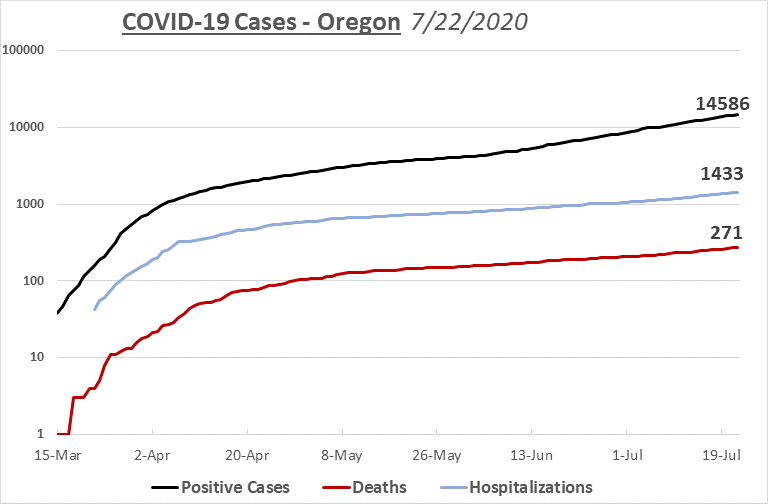
TODAY’S CORONAVIRUS AND CORONAVIRUS RESPONSE UPDATE
-
Positive Cases: OHA reports that 231 additional Oregonians have tested positive for COVID. The cumulative total for those testing positive is 14,586.
-
Total Tests: The number of tests increased by 7,508. The cumulative total is now 351,987.
-
Ratio: The percentage of positive tests for today has gone down to 3.1% of total tests. The national percentage today is 8.8%.
-
Deaths: I’m sorry to have to report 2 additional deaths due to the coronavirus today. Further down in the newsletter, you’ll find information about those we’ve most recently lost. The total number of deaths in Oregon in now 271.
-
Hospitalized: OHA is reporting 27 new COVID hospitalizations. The cumulative number of those who have been hospitalized with COVID is now 1,433.
-
Presumptive Cases: OHA is now including “presumptive COVID-19 cases” in its daily reports, consistent with recently amended guidance from the Centers for Disease Control and Prevention. A presumptive case is someone who does not yet have a positive PCR test result but is showing symptoms and has had close contact with a confirmed case. If they later test positive by PCR, those will be recategorized as confirmed cases. OHA reports an additional 33 presumed positives today. The total number of presumed positives is now 807.
-
Other Hospital Information:
- Patients Currently w COVID-19 Symptoms (who may or may not have received a positive test result yet): 231 (6 fewer than yesterday). Of those, 166 have already received a positive test back.
- Available ICU Beds: 150 (8 more than yesterday).
- Other Available Beds: 635 (83 fewer than yesterday).
- ICU Patients w COVID-19 Symptoms: 61 (3 fewer than yesterday).
- COVID-19 Patients Currently on Ventilators: 30 (4 fewer than yesterday).
- Available Ventilators: 779 (3 more than yesterday).
-
Dashboards
-
Today’s National Numbers:
-
PPE:
-
Additional Brief Updates:
- The Oregon Department of Education released the second revision of its reopening guidelines this afternoon. (The third and final revision will come on August 11.) You can read the guidelines here. As was the case with the previous revision, it clarifies and adds to the previous version(s), based on issues that have arisen and an increasing understanding of how COVID spreads. The first five pages of the document is a listing of the changes (which are in green in the document itself), but only a few of them would be considered major. I haven’t read through it all yet, but the biggest change that I’ve noticed is the requirement for all kids in Kindergarten and above to wear face-coverings while at school. (Same for their teachers and other staff, of course.) This is increasingly seen as a key prerequisite for returning to in-person instruction safely. I’ll let you know in future newsletters about additional issues in the guidelines, and some of the difficult decisions that need to be made.
- As I mentioned in discussing the most recent Weekly Testing Report, we are hearing reports of long waits (up to two weeks) for tests to be processed at some of the national testing labs, as a result of the huge outbreaks that we’re seeing around the country. Needless to say, it calls into question the possibility of doing effective contact tracing (which is triggered by a positive test result) when that process doesn’t begin until 2-3 weeks after a person became infected. OPB has a good in-depth look at this problem. They quote the Malheur County Public Health Director recommending that for now anyone who has COVID-like symptoms should assume they have it while they’re waiting for the test results to come back. That means self-isolating for ten days if they can, after which time they should no longer be contagious. Presumably, their family members should do the same. If they don’t have protected sick leave either through their employment or through the federal CARES Act, the Legislature recently appropriated $30 million to help them.
Governor Announces Changes to Reopening Rules
In her press conference this morning, the Governor laid out some necessary steps for the state to take in pushing down the current resurgence of cases. The changes are not as restrictive as steps that other states are taking, but it makes sense given that our resurgence is not at the same scale as those other states. They all begin this Friday, July 24. Here are the changes she presented:
- Face coverings will be REQUIRED for children ages 5 and up (in indoor public spaces and outdoor spaces in which six feet of distancing can’t be assured). Face coverings are RECOMMENDED for children between the ages of two and five. They are NOT RECOMMENDED for children younger than age two.
- Face coverings will be required when exercising in public indoor spaces (i.e., gyms and exercise studios), as well as outdoors when physical distancing can’t be maintained.
- Restaurants and bars statewide will be required to close at 10 pm, regardless of their reopening phase.
- The capacity limits for indoor gatherings will go down from 250 to 100, including staff. This includes concert halls, theaters, churches and similar indoor venues.
- The limit for outdoor gatherings remains at 250.
She also mentioned that she is in conversations with her medical team and with neighboring states about putting limits on tourism (or requiring quarantining) from states or areas that have been big COVID hotspots. We should hear more about those discussions soon.
She also indicated that we will be seeing some changes related to the County Watch List—those eight counties identified as having significant community spread of the virus. Some are doing better and will likely be taken off the list, while others may need further restrictions. Also, there may be additional counties that need to be put on the Watch List. We’ll know more by the end of the week.
Finally, she did have a piece of good news: people will soon be able to have outdoor visits with family members living in congregate care facilities, as long as the facility has no active COVID cases.
Governor Brown was accompanied by Dr. Dean Sidelinger, the State Epidemiologist, who provided the medical rationale for the decisions being made. His reasoning and assessment of where we are in the trajectory of the disease were reproduced in a release from DHS/OHA that just came out.
COVID Weekly Report Released
OHA released its weekly COVID report today. It is again a very comprehensive snapshot of different aspects of transmission of the disease in Oregon.
Large outbreaks (Table 7) have contributed a diminishing proportion of recent cases, and sporadic cases have increased (Figure 1), consistent with diffuse community spread. Though not definitive, a diminishing proportion of cases that are linked to outbreaks, cluster and household spread, is consistent with increasingly timely and effective isolation and quarantine messages from public health investigators and tracers. Slightly fewer than 95% of cases identified on most recent days were contacted by local public health staff within 24 hours, suggesting that more investigatory resources are needed.
Here are some of OHA’s broad observations of where we are now, based on data from July 13-19:
- We are seeing a continued resurgence in COVID-19 transmission, with cases rising by 2,409, a 26% increase over the previous week.
- The percentage of positive test results increased from 6.2% to 6.6%. (It had been 5% the last week of June.)
- The statewide infection rate is now 35 cases per 10,000 Oregonians (up from 29.4 cases).
- 25 Oregonians were reported to have died last week, up from 22 the previous week.
- A record weekly number of 37,137 COVID tests was reported, up from 32,355. the previous week.
- Hospitalizations appear to have plateaued at a high level, but they remain below earlier peaks in March and April despite increases in infections overall.
- OHA continues to believe that this is because younger people, who have lower risk of hospitalization and death, predominate among recent cases.
- We’re still seeing large outbreaks at workplaces and long-term care facilities but they are a smaller proportion of the overall new cases.
- This is likely due to a combination of better contact tracing and containment of workplace outbreaks and an increase in what OHA calls “sporadic cases,” which suggests that the disease is spreading more broadly into the community.
- Again this week fewer than 95% of cases identified on most recent days are able to be contacted by local public health staff within 24 hours, a reflection of the increased numbers and the greater degree of community spread.
The report again provides information about signs, symptoms, and risk factors; racial/ethnic/age/gender demographics; recovery; outbreaks in long-term care; workplace outbreaks; hospital rates; and the breakdown of cases by zip code.
Racial/Ethnic
The report again demonstrates significant disparities among racial groups. You can see this in the charts below, with data that I’ve taken from the July 8 report, the July 15 report, and from this report. It allows you to see at a glance the proportion of case counts within different racial groups and ethnic groups (technically, “Hispanic” is not a race and is counted as an ethnic group, with numbers from a separate chart).
You’ll see again how much higher the rates per 10,000 are for most racial/ethnic groups compared to White Oregonians. Black Oregonians are a little over four times more likely to contract the disease than are White Oregonians, Native Americans nearly four times more likely, Latinx Oregonians are six times more likely, and Pacific Islanders an incredible 13 times more likely. You’ll also again see that the percentages of those hospitalized or dying from the disease are significantly lower for non-Whites than for the population of White Oregonians. The percentage of infections that lead to hospitalizations and to death continues to go down in nearly every racial/ethnic group.
The OHA has confirmed that this may be a function of age: many of those contracting the virus via workplace outbreaks are from BIPOC (Black, Indigenous, People of Color) populations. These frontline workers at care centers and food processing centers tend to be younger and thus somewhat less likely to experience severe consequences from the disease.
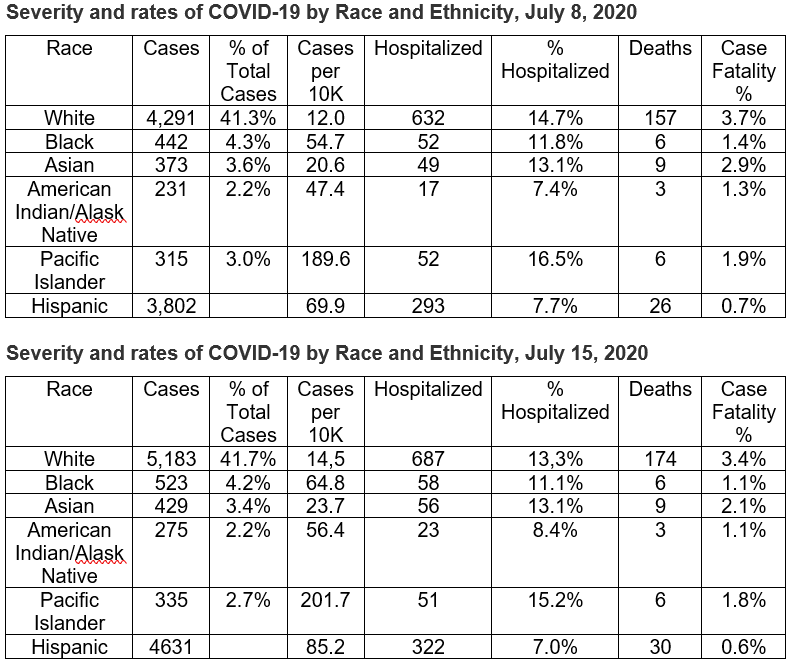 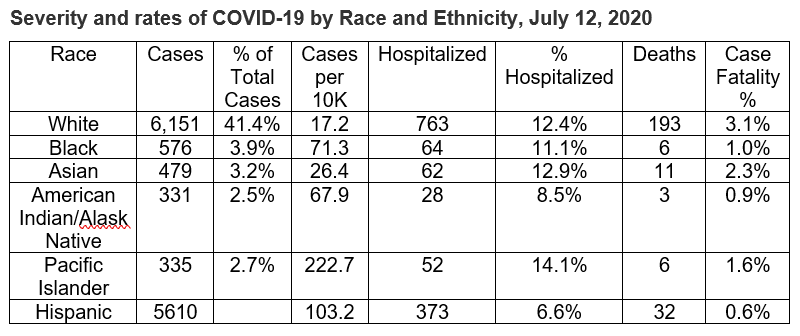
Long-Term Care Facilities
We appear to be seeing a gradual slowing down of outbreaks in long-term care facilities, with more facilities moving from “active” to “resolved” status.
This week’s report lists outbreaks in 29 (up from down from 35) long-term care facilities that are still considered active. They are responsible for 416 cases (down from 528) and 31 deaths (down from 44). In addition, there are 45 outbreaks considered resolved (up from 39). They are responsible for 816 cases (up from 610) and 119 deaths (up from 102).
The total for active and resolved facilities is thus 1,232 cases (up by 94 from last week) and 150 deaths (up by just 4 from last week). The listed facilities include all where there was at least one death and at least three cases, so the above total should include all of the deaths in Oregon, but there may be additional cases out there that are not included.
Workplace Outbreaks
Similarly, there are separate listings for workplace outbreaks that are “active” and “resolved,” but without deaths identified by workplace. So far, eight deaths have been the result of workplace outbreaks, a figure unchanged for quite some time.
You’ll find 59 workplaces listed as “Active” this week, totaling 1,323 cases. Forty-five are listed as “Resolved,” totaling 1,057 cases. Those listed include workplaces with at least 5 cases identified among workers or family members. They are listed in descending order of number of cases.
OHA points out that the higher number of COVID cases among people of color can in part be tied to their being overrepresented in agricultural and correctional settings, where it’s difficult to contain the spread of the virus.
I will add that it would be wrong to think that the products produced at these workplaces are tainted in some way. OHA is clear that their products do not pose a risk to the public. The challenge is that workers cannot separate their work and their everyday lives. They are bringing the virus into the facilities from their communities, spreading it there, and then taking it back out into the community.
Childcare Outbreaks
The Weekly Report again includes names and case counts for child care facilities that enroll 30 or more children and have five or more cases. KinderCare in Lake Oswego and a facility in Nyssa in Malheur County are again listed, and now they are joined by a third: Hall Boulevard KinderCare in Tigard.
The Weekly Report also includes the total number of facilities statewide—no matter how many children they enroll—that have five or more cases. There have been two such facilities.
Infections by Zip Code
You’ll see that the zip code list again reveals the various hot spots around the state, presented in terms of cases per 10K residents. The top five should come as no surprise:
- 97838 (Hermiston in Umatilla and Morrow Counties)
- 97761 (Warm Springs in Jefferson County)
- 97365 (Newport in Lincoln County)
- 97818 (Boardman in Morrow County)
- 97882 (Umatilla in Umatilla County),
Three out of the top five zip codes are again where food processing workers in the Morrow/Umatilla area live (as was #6 if I had gone that far).
Here is a zip code locator for you to use as you look at the zip code numbers.
OHA Rolls Out New Face Covering Website
To help Oregonians understand the requirement, the Oregon Health Authority has created a website resource that aims to be a clearinghouse of the latest information about face coverings and masks, from requirements to FAQs to tips about how to effectively wear them. You'll find it here.
Next Set of Ways and Means Subcommittees Meetings Tomorrow
Last week I shared with you the proposed plan to rebalance the state budget in preparation for the next special session that will likely be held in August.
The various Ways and Means Subcommittees will be meeting in public session started meeting this morning and will continue Thursday and Friday.
Here’s the schedule for those meetings. If you click on the links, you’ll see the agendas for each of the subcommittees and can click on “Meeting Materials” to see the detailed proposals for each major budget area. The agenda page will tell you how to sign up to testify orally or via written testimony. You can watch the meeting by clicking on the video icon.
Thursday, July 23:
Education: 9 am-12 pm https://olis.oregonlegislature.gov/liz/2019I1/Committees/JWMED/2020-07-23-09-00/Agenda
Human Services: 1-4 pm https://olis.oregonlegislature.gov/liz/2019I1/Committees/JWMHS/2020-07-23-13-00/Agenda
Friday, July 24:
Public Safety: 9 am-12 pm https://olis.oregonlegislature.gov/liz/2019I1/Committees/JWMPS/2020-07-24-09-00/Agenda
Transportation and Economic Development: 1-4 pm https://olis.oregonlegislature.gov/liz/2019I1/Committees/JWMTR/2020-07-24-13-00/Agenda
Where Are Today’s New Cases?
If we put together the positive test results and new “presumptive” cases reported today, the overall number of new cases is 264. More than half of the state’s new cases are again from 25 counties outside the Portland Tri-County region. Here is the breakdown by county for today:
Baker (1)
Benton (3)
Clackamas (24)
Clatsop (1)
Coos (3)
Crook (2)
Curry (1)
Deschutes (8)
Douglas (2)
Grant (1)
Hood River (4)
Jackson (11)
Jefferson (8)
Josephine (1)
Klamath (6)
Lane (6)
Lincoln (2)
Linn (6)
Malheur (13)
Marion (31)
Morrow (3)
Multnomah (51)
Polk (4)
Umatilla (24)
Union (2)
Wasco (1)
Washington (45)
Yamhill (4)
And the Deaths
Both of today’s deaths are from residents of Umatilla County:
Oregon’s 270th COVID-19 death is a 77-year-old man in Umatilla County who tested positive on July 9 and died on July 20, in his residence.
Oregon’s 271st COVID-19 death is an 82-year-old man in Umatilla County who tested positive on July 16 and died on July 21, at Good Shepherd Hospital in Hermiston.
Additional Graphs:
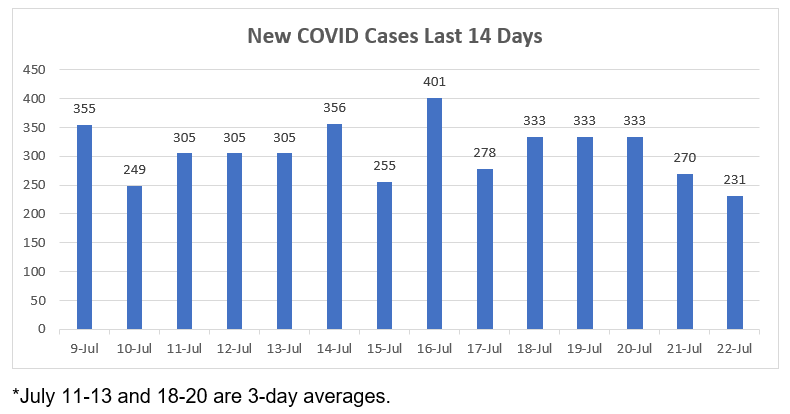
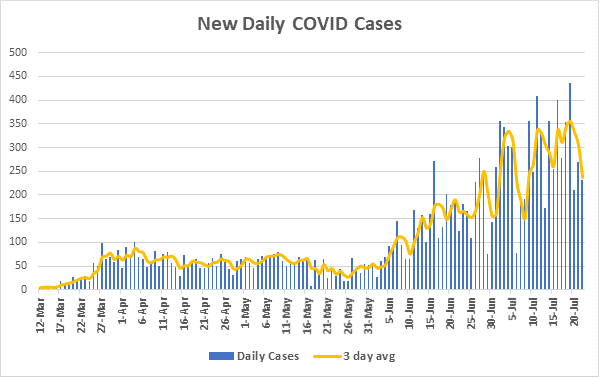
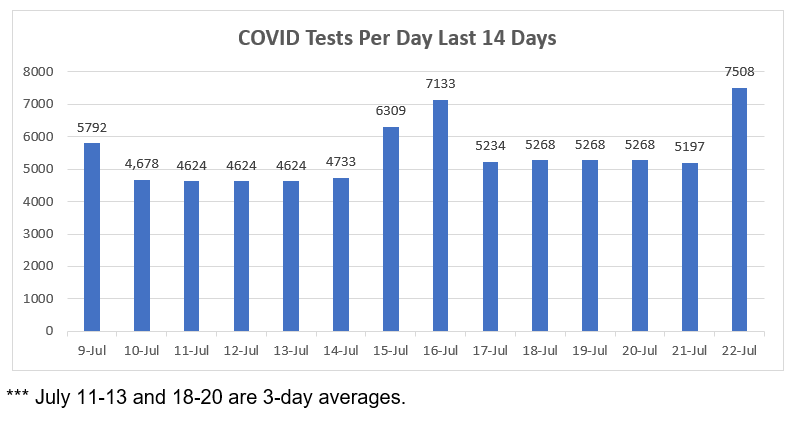
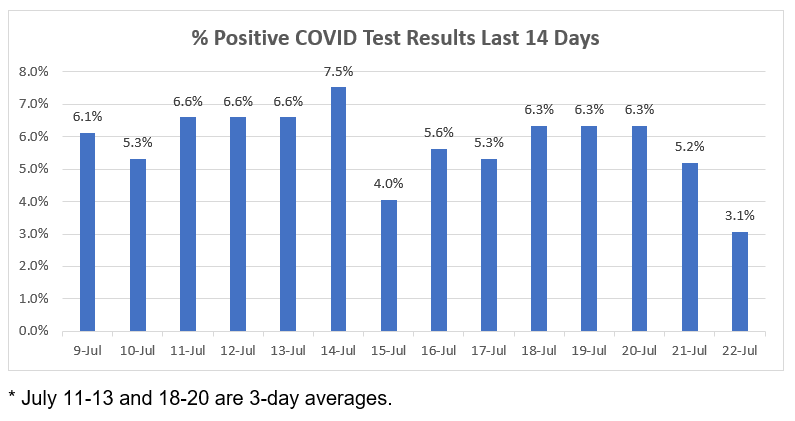


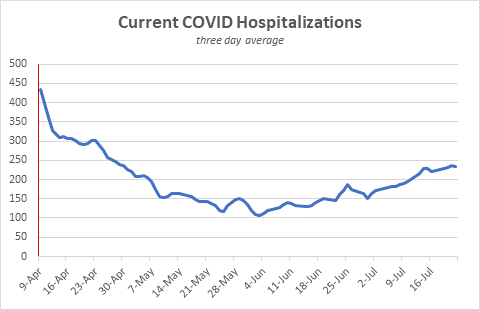

Want to See Past Newsletters?
If there was COVID-related information in a past newsletter that you want to go back to, but find you’ve deleted it, you can always go to my legislative website (www.senatordembrow.com), click on “News and Information,” and you’ll find them all there. Also, if someone forwarded you this newsletter and you’d like to get it directly, you can sign up for it there.

AND FINALLY,
Here again are some resources that you will find useful:
If the above links are not providing you with answers to your questions or directing you to the help that you need, please consider me and my office to be a resource. We’ll do our best to assist you or steer you in the right direction.
Best,
 Senator Michael Dembrow
District 23
email: Sen.MichaelDembrow@oregonlegislature.gov
web: www.senatordembrow.com
phone: 503-986-1723
mail: 900 Court St NE, S-407, Salem, OR, 97301
|